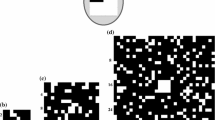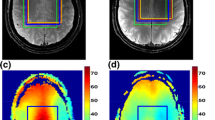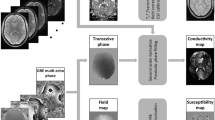Abstract
Objective
Investigation of the feasibility and performance of phosphorus (31P) magnetic resonance spectroscopic imaging (MRSI) at 9.4 T with a three-layered phosphorus/proton coil in human normal brain tissue and tumor.
Materials and methods
A multi-channel 31P coil was designed to enable MRSI of the entire human brain. The performance of the coil was evaluated by means of electromagnetic field simulations and actual measurements. A 3D chemical shift imaging approach with a variable repetition time and flip angle was used to increase the achievable signal-to-noise ratio of the acquired 31P spectra. The impact of the resulting k-space modulation was investigated by simulations. Three tumor patients and three healthy volunteers were scanned and differences between spectra from healthy and cancerous tissue were evaluated qualitatively.
Results
The high sensitivity provided by the 27-channel 31P coil allowed acquiring CSI data in 22 min with a nominal voxel size of 15 × 15 × 15 mm3. Shimming and anatomical localization could be performed with the integrated four-channel proton dipole array. The amplitudes of the phosphodiesters and phosphoethanolamine appeared reduced in tumorous tissue for all three patients. A neutral or slightly alkaline pH was measured within the brain lesions.
Conclusion
These initial results demonstrate that 31P 3D CSI is feasible at 9.4 T and could be performed successfully in healthy subjects and tumor patients in under 30 min.








Similar content being viewed by others
References
Patel N, Forton DM, Coutss GA, Thomas HC, Taylor-Robinson SD (2000) Intracellular pH measurements of the whole head and the basal ganglia in chronic liver disease: a phosphorus-31 MR spectroscopy study. Metab Brain Dis 15(3):233–240
Negendank W (1992) Studies of human tumors by MRS: a review. NMR Biomed 5(5):303–324
Hoang T, Bluml S, Dubowitz D, Moats R, Kopyov O, Jacques Ross B (1998) Quantitative proton-decoupled 31P MRS and 1H MRS in the evaluation of Huntington’s and Parkinson’s diseases. Neurology 50(4):1033–1040
Rango M, Bozzali M, Prelle A, Scarlato G, Bresolin N (2001) Brain activation in normal subjects and in patients affected by mitochondrial disease without clinical central nervous system involvement: a phosphorus magnetic resonance spectroscopy study. J Cereb Blood Flow Metab 21(1):85–91
Barbiroli B, Montagna P, Martinelli P, Lodi R, Iotti S, Cortelli P, Funicello R, Zaniol P (1993) Defective brain energy metabolism shown by in vivo 31P MR spectroscopy in 28 patients with mitochondrial cytopathies. J Cereb Blood Flow Metab 13(3):469–474
Podo F (1999) Tumour phospholipid metabolism. NMR Biomed 12(7):413–439
Aboagye EO, Bhujwalla ZM (1999) Malignant transformation alters membrane choline phospholipid metabolism of human mammary epithelial cells. Cancer Res 59(1):80–84
Keshari KR, Tsachres H, Iman R, Delos Santos L, Tabatabai ZL, Shinohara K, Vigneron DB, Kurhanewicz J (2011) Correlation of phospholipid metabolites with prostate cancer pathologic grade, proliferative status and surgical stage—impact of tissue environment. NMR Biomed 24(6):691–699
Swanson MG, Keshari KR, Tabatabai ZL, Simko JP, Carroll PR, Zektzer AS, Kurhanewicz J (2008) Quantification of choline- and ethanolamine-containing metabolites in human prostate tissues using 1H HR-MAS total correlation spectroscopy. Magn Reson Med 60(1):33–40
Lagemaat M, Vos E, Maas M, Bitz A, Orzada S, van Uden M, Kobus T, Heerschap A, Scheenen T (2014) Phosphorus magnetic resonance spectroscopic imaging at 7 T in patients with prostate cancer. Invest Radiol 49(5):363–372
Ren J, Sherry AD, Malloy CR (2015) 31P-MRS of healthy human brain: ATP synthesis, metabolite concentrations, pH, and T1 relaxation times. NMR Biomed 28(11):1455–1462
Lei H, Zhu XH, Zhang XL, Ugurbil K, Chen W (2003) In vivo 31P magnetic resonance spectroscopy of human brain at 7 T: an initial experience. Magn Reson Med 49(2):199–205
Brown R, Lakshmanan K, Madelin G, Parasoglou P (2016) A nested phosphorus and proton coil array for brain magnetic resonance imaging and spectroscopy. Neuroimage 124:602–611
van de Bank BL, Orzada S, Smits F, Lagemaat MW, Rodgers CT, Bitz AK, Scheenen TWJ (2015) Optimized 31P MRS in the human brain at 7 T with a dedicated RF coil setup. NMR Biomed 28:1570–1578
Goluch S, Kuehne A, Meyerspeer M, Kriegl R, Schmid AI, Fiedler GB, Herrmann T, Mallow J, Hong SM, Cho ZH, Bernarding J, Moser E, Laistler E (2014) A form-fitted three channel 31P, two channel 1H transceiver coil array for calf muscle studies at 7 T. Magn Reson Med 73(6):2376–2389
Luttje MP, Italiaander MGM, Arteaga de Castro CS, van der Kemp WJM, Luijten PR, van Vulpen M, van der Heide UA, Klomp DWJ (2014) (31P) MR spectroscopic imaging combined with (1) H MR spectroscopic imaging in the human prostate using a double tuned endorectal coil at 7T. Magn Reson Med 72(6):1516–1521
Rodgers CT, Clarke WT, Snyder C, Vaughan JT, Neubauer S, Robson MD (2014) Human cardiac 31P magnetic resonance spectroscopy at 7 Tesla. Magn Reson Med 72:304–315
Panda A, Jones S, Stark H, Raghavan RS, Sandrasegaran K, Bansal N, Dydak U (2012) Phosphorus liver MRSI at 3 T using a novel dual-tuned eight-channel 31P/1H H coil. Magn Reson Med 68(5):1346–1356
Chmelik M, Považan M, Krššák M, Gruber S, Tkačov M, Trattnig S, Bogner W (2014) In vivo (31)P magnetic resonance spectroscopy of the human liver at 7 T: an initial experience. NMR Biomed 27:478–485
Murphy-Boesch J, Stoyanova R, Srinivasan R, Willard T, Vigneron D, Nelson S, Taylor JS, Brown TR (1993) Proton-decoupled 31P chemical shift imaging of the human brain in normal volunteers. NMR Biomed 6(3):173–180
Shaka AJ, Keeler J, Freeman R (1983) Evaluation of a new broadband decoupling sequence: WALTZ-16. J Magn Reson 53(2):313–340
Kupce Ē, Freeman R (1996) Optimized adiabatic pulses for wideband spin inversion. J Magn Reson Ser A 118(2):299–303
Brown TR, Kincaid BM, Ugurbil K (1982) NMR chemical shift imaging in three dimensions. Proc Natl Acad Sci USA 79(11):3523–3526
Maudsley AA, Hilal SK, Perman WH, Simon HE (1983) Spatially resolved high resolution spectroscopy by ``four-dimensional’’ NMR. J Magn Reson 51(1):147–152
Shajan G, Mirkes C, Buckenmaier K, Hoffmann J, Pohmann R, Scheffler K (2015) Three-layered radio frequency coil arrangement for sodium MRI of the human brain at 9.4 Tesla. Magn Reson Med. doi:10.1002/mrm.25666
Hoffmann J, Shajan G, Scheffler K, Pohmann R (2014) Numerical and experimental evaluation of RF shimming in the human brain at 9.4 T using a dual-row transmit array. Magn Reson Mater Phys 27(5):373–386
Christ A, Kainz W, Hahn EG, Honegger K, Zefferer M, Neufeld E, Rascher W, Janka R, Bautz W, Chen J, Kiefer B, Schmitt P, Hollenbach HP, Shen J, Oberle M, Szczerba D, Kam A, Guag JW, Kuster N (2010) The virtual family—development of surface-based anatomical models of two adults and two children for dosimetric simulations. Phys Med Biol 55(2):N23–N38
Allen SP, Morrell GR, Peterson B, Park D, Gold GE, Kaggie D, Bangerter NK (2011) Phase-sensitive sodium B1 mapping. Magn Reson Med 65(4):1125–1130
Robson PM, Grant AK, Madhuranthakam AJ, Lattanzi R, Sodickson DK, McKenzie CA (2008) Comprehensive quantification of signal-to-noise ratio and g-factor for image-based and k-space-based parallel imaging reconstructions. Magn Reson Med 60(4):895–907
Qian Y, Boada FE (2008) Acquisition-Weighted Stack of Spirals for Fast Echo Time MR Imaging. Magn Reson Med 60(1):135–145
Webb AG, Briggs RW, Mareci TH (1991) Volume-localized spectroscopy using selective Fourier-transform with windowing by variable-tip-angle excitation. J Magn Reson 94:174–179
Kuhn B, Dreher W, Norris DG, Leibfritz D (1996) Fast proton spectroscopic imaging employing k-space weighting achieved by variable repetition times. Magn Reson Med 35:457–464
Rodgers CT, Robson MD (2015) Coil combination for receive array spectroscopy: Are data-driven methods superior to methods using computed field maps? Magn Reson Med. doi:10.1002/mrm.25618
Naressi A, Couturier C, Devos JM, Janssen M, Mangeat C, De Beer R, Graveron-Demilly D (2001) Java-based graphical user interface for the MRUI quantitation package. Magn Reson Mater Phys 12(2–3):141–152
Vanhamme L, Van Den Boogaart A, Van Huffel S (1997) Improved method for accurate and efficient quantification of MRS data with use of prior knowledge. J Magn Reson 129(1):35–43
Shajan G, Kozlov M, Hoffmann J, Turner R, Scheffler K, Pohmann R (2014) A 16-channel dual-row transmit array in combination with a 31-element receive array for human brain imaging at 9.4 T. Magn Reson Med 71(2):870–879
Bogner W, Chmelik M, Schmid AI, Moser E, Trattnig S, Gruber S (2009) Assessment of 31P relaxation times in the human calf muscle: a comparison between 3 T and 7 T in vivo. Magn Reson Med 62(3):574–582
Keil B, Blau JN, Biber S, Hoecht P, Tountcheva V, Setsompop K, Triantafyllou C, Wald LL (2013) A 64-channel 3T array coil for accelerated brain MRI. Magn Reson Med 70(1):248–258
Renema WKJ, Kan HE, Wieringa B, Heerschap A (2007) In vivo magnetic resonance spectroscopy of transgenic mouse models with altered high-energy phosphoryl transfer metabolism. NMR Biomed 20:448–467
Ha DH, Choi S, Oh JY, Yoon SK, Kang MJ, Kim KU (2013) Application of 31P MR spectroscopy to the brain tumors. Korean J Radiol 14(3):477–486
Chmelík M, Kukurová IJ, Gruber S, Krššák M, Valkovič L, Trattnig S, Bogner W (2013) Fully adiabatic 31P 2D-CSI with reduced chemical shift displacement error at 7 T-GOIA-1D-ISIS/2D-CSI. Magn Reson Med 69(3):1233–1244
Lu A, Atkinson IC, Zhou XJ, Thulborn KR (2013) PCr/ATP ratio mapping of the human head by simultaneously imaging of multiple spectral peaks with interleaved excitations and flexible twisted projection imaging readout trajectories at 9.4 T. Magn Reson Med 69(2):538–544
Stubbs M, Bhujwalla ZM, Tozer GM, Rodrigues LM, Maxwell RJ, Morgan R, Howe FA, Griffiths JR (1992) An assessment of 31P MRS as a method of measuring pH in rat tumours. NMR Biomed 5(6):351–359
Taylor JS, Vigneron DB, Murphy-Boesch J, Nelson SJ, Kessler HB, Coia L, Curran W, Brown TR (1991) Free magnesium levels in normal human brain and brain tumors: 31P chemical-shift imaging measurements at 1.5 T. Proc Natl Acad Sci USA 88(15):6810–6814
Segebarth CM, Baleriaux DF, de Beer R, van Ormondt D, Marien A, Luyten PR, den Hollander JA (1989) 1H image-guided localized 31P MR spectroscopy of human brain: quantitative analysis of 31P MR spectra measured on volunteers and on intracranial tumor patients. Magn Reson Med 11(3):349–366
Hubesch B, Sappey-Marinier D, Roth K, Meyerhoff D, Matson G, Weiner MW (1991) P-31 MR spectroscopy of normal human brain and brain tumors. Radiology 174(2):401–409
Griffiths JR (1991) Are cancer cells acidic? Br J Cancer 64(3):425–427
Ng TC, Majors AW, Vijayakumar S, Baldwin NJ, Thomas FJ, Koumoundouros I, Taylor ME, Grundfest SF, Meaney TF, Tubbs RR (1989) Human neoplasm pH and response to radiation therapy: P-31 MR spectroscopy studies in situ. Radiology 170(3 Pt 1):875–878
Bhakoo KK, Williams SR, Florian CL, Land H, Noble MD (1996) Immortalization and transformation are associated with specific alterations in choline metabolism. Cancer Res 56:4630–4635
Acknowledgments
The authors thank C.T. Rodgers and M.D. Robson for providing a Matlab implementation of the WSVD algorithm as supporting material for their paper. This work was funded in part by the Helmholtz Alliance ICEMED—Imaging and Curing Environmental Metabolic Diseases, through the Initiative and Networking Fund of the Helmholtz Association.
Author information
Authors and Affiliations
Corresponding author
Ethics declarations
Conflict of interest
The authors declare that they have no conflicts of interest.
Ethical standards
All procedures performed in studies involving human participants were in accordance with the ethical standards of the institutional and/or national research committee and with the 1964 Helsinki declaration and its later amendments or comparable ethical standards.
Informed consent
Informed consent was obtained from all individual participants included in the study.
Additional information
Christian Mirkes and Gunamony Shajan have contributed equally to this wok.
Rights and permissions
About this article
Cite this article
Mirkes, C., Shajan, G., Chadzynski, G. et al. 31P CSI of the human brain in healthy subjects and tumor patients at 9.4 T with a three-layered multi-nuclear coil: initial results. Magn Reson Mater Phy 29, 579–589 (2016). https://doi.org/10.1007/s10334-016-0524-9
Received:
Revised:
Accepted:
Published:
Issue Date:
DOI: https://doi.org/10.1007/s10334-016-0524-9




